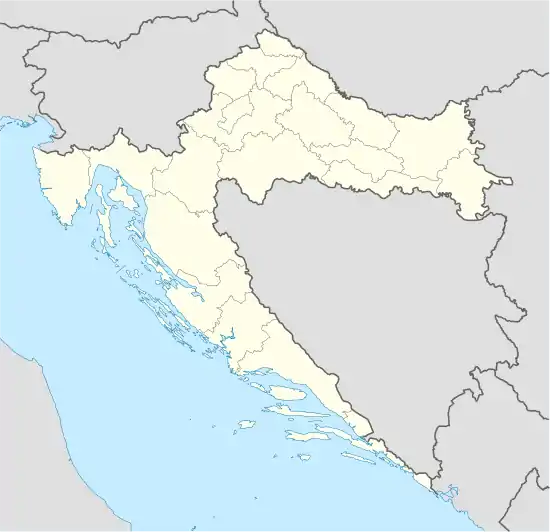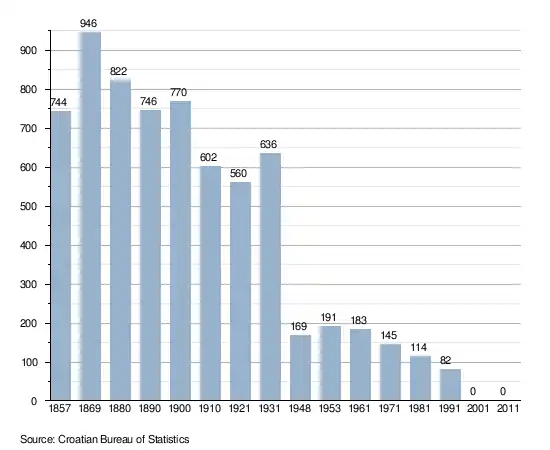Sadilovac
Sadilovac is an uninhabited settlement in the Kordun region of Croatia, in the municipality of Rakovica, Karlovac County.
Sadilovac | |
|---|---|
Village | |
| Sadilovac | |
 Sadilovac Location Of Sadilovac in Croatia | |
| Coordinates: 44°56′24″N 15°43′05″E | |
| Country | |
| Region | Continental Croatia |
| County | Karlovac |
| Municipality | Rakovica |
| Elevation | 380 m (1,250 ft) |
| Population (2011)[1] | |
| • Total | 0 |
| Time zone | UTC+1 (CET) |
| • Summer (DST) | UTC+2 (CEST) |
| Postal code | 47246 Drežnik Grad |
| Area code(s) | (+385) 47 |
History
The village of Sadilovac was established in the 18th century as evidenced by the arrangement of houses along the road and the church situated at the entrance of the settlement.[2]
Culture
Orthodox church, built in 1826, was burnt down by Ustaše on 31 July 1942. The reconstruction of the church, which only started in 1989 and included reconstruction of the roof and installation of two new bells, has never been fully completed due to the 1991-1995 war.
The memorial plaque with the names of 463 civilian victims of the Sadilovac massacre of 1942, engraved in stone, is kept inside the church. The remains of the victims are buried next to the church.[3]
The Sadilovac Orthodox Parish, which belongs to the Eparchy of Gornji Karlovac, includes the villages of Drežnik, Smoljanac (Lika), Grabovac, Lipovača, Sadilovac, Irinovac (Lika), Vaganac (Lika) i Korana.
Demographics
According to the 2001 and 2011 censuses,[1] the village of Sadilovac has no inhabitants. The village ceased to exist in August 1995,[4] in the course of the Croatian military operation Storm, aimed at recapturing the territory held by the rebel, ethnic Serb residents.
The 1991 census[5] recorded that 81.71% of the village population were ethnic Serbs (67/82), 10.98% were ethnic Croats (9/82), 3.65% were Yugoslavs (3/82) and 3.65% were of other ethnic origin (3/82).
Historical population 1857-2011 [1][6]

Notable natives and residents
- Čedo Rajačić (16 April 1904 — 1 February 1985) - lawyer and university professor at Faculty of Law, University of Zagreb[7]
- Nikola Radmanović (1869 — 2 August 1941) - priest of the Serbian Orthodox church
See also
- Sadilovac massacre in World War II, 31 July 1942[8] in which 463 Orthodox residents from Sadilovac and neighbouring villages lost their lives at hands of Ustaše.
References
- "Population by Age and Sex, by Settlements, 2011 Census: Sadilovac". Census of Population, Households and Dwellings 2011. Zagreb: Croatian Bureau of Statistics. December 2012.
- Filip Škiljan, “Kulturno – historijski spomenici Korduna s pregledom povijesti Korduna od prapovijesti do 1881. ”/"Cultural and Historical Heritage of Kordun with Review of Kordun History from Pre-history to 1881", Srpsko Narodno Vijece/Serb National Council, pg 30 & 31, Zagreb, 2007, ISBN 978-953-7442-01-9
- Filip Škiljan, “Kulturno – historijski spomenici Korduna s pregledom povijesti Korduna od prapovijesti do 1881. ”/"Cultural and Historical Heritage of Kordun with Review of Kordun History from Pre-history to 1881", Srpsko Narodno Vijece/Serb National Council, pg 30 & 31, Zagreb, 2007, ISBN 978-953-7442-01-9
- "Vrijeme je stalo u kolovozu 1995". p-portal.net (in Croatian). 8 August 2014. Retrieved 24 February 2018.
- Izdanje Državnog zavoda za statistiku RH: Narodnosni sastav stanovništva RH od 1880-1991. godine.
- Naselja i stanovništvo Republike Hrvatske 1857-2001, www.dzs.hr
- "Prilozi za biografiju Dr Čede Rajačića: Od logora do oslobođenja" (in Croatian). 18 December 2018. Retrieved 24 December 2018.
- "Vrijeme je stalo u kolovozu 1995". p-portal.net (in Croatian). 8 August 2014. Retrieved 24 February 2018.